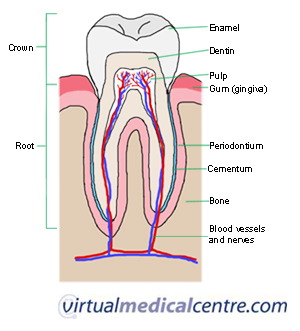- An Introduction to Teeth
- Purpose of Teeth
- Classification and Location of Teeth
- Eruption Sequence of Permanent Dentition
- Impacted Teeth
- Tooth Structure
An Introduction to Teeth
Adult teeth or permanent teeth replace the primary teeth. They aid in digestion, speech and general appearance. There are 32 permanent teeth, with the main difference from primary teeth is that there are 4 premolars and 6 molars in each arch. Permanent teeth begin erupting at 6yrs of age and end at 21yrs of age. Some people may not have some if not all their 3rd molars due to evolutionary changes leading to the lack of development of these teeth. 3rd molars may not erupt due to becoming embedded in jaw. The tooth consists of a crown and root, and the tooth is composed of different materials that aid in strengthening, preserving and maintaining its function.
Purpose of Teeth
- To breakdown food into smaller pieces to aid in the process of digestion
- Helps with speech
- Personal appearance
Classification and Location of Teeth
- There are 32 permanent teeth
- There are 16 teeth on both the top and bottom jaw
- Each jaw consists of specific teeth, which are incisors (cutting teeth), canines (tearing teeth) and molars (grinding teeth).
- From the midline of one side of each jaw consists of 2 incisors, 1 canine, 2 premolars and 3 molars.
Eruption Sequence of Permanent Dentition
- Central incisors= 6-8 yrs
- Lateral incisors= 6.5-8.5yrs
- Canine = 9-13 yrs
- 1st Premolars= 9.5-11.5yrs
- 2nd Premolars= 10-13yrs
- 1st Molars =5.5-7yrs
- 2nd Molars= 11-13yrs
- 3rd Molars= 17-21yrs
Get on top of your dental health
Find and instantly book affordable dentists within Australia
Impacted Teeth
- Teeth that fail to emerge of erupt through the gums are impacted teeth .
- Also known as unemerged or unerupted teeth.
- Most common teeth to become impacted are 3rd molars (wisdom teeth) due to the fact they are the last teeth to emerge.
- Often due to a small jaw that prevents eruption of the teeth.
- Impacted teeth do not usually cause any problems, however, they may lead to malignment of neighbouring teeth or become imflammed leading to pain and bad breath.
- The presence of an impacted tooth is confirmed by x-ray.
- If impacted tooth is problematic, surgical removal is often necessary but over the counter pain relievers and antiseptic mouth wash may be sufficient in treating the condition.
Tooth Structure
- The anatomy of the tooth consists of root (hidden in the gums) and crown (visible part of the tooth).
- The root of the tooth functions as an anchor for the tooth and allows for blood and nerve supply to enter the tooth to maintain its viability.
- The crown is the surface that allows for food breakdown as opposing teeth are brought together when chewing.
- The crown and root consists of hard and soft tissue.
- The hard tissue covering the crown is called enamel, a hard mineral surface, where as the root is covered by cementum, a hardy mineral surface, however, it is softer compared to enamel.
- The next layer under both enamel and cementum is dentin, the main bulk of the tooth. Dentin is considered a hard tissue, however, it is much more porous than either of the other hard tissues to allow nutrients to be transferred through the tooth layers.
- The next layer under dentin is the pulp tissue that is housed in pulp cavity. The pulp cavity has a rich blood supply and nerve supply, which is essential for maintaining tooth health.
- The root of the tooth is embedded in bone, which is covered in tissue called gingiva. The root is held in place by strands of tissue that originated from the surrounding bone and embedded into cementum. These strands of tissue are called periodontal ligaments.
References
- Ash M: Wheeler’s Dental anatomy, physiology and occlusion. 7th edition, Philadephia, W.B. Saunders Company,1993.
- Moore K, Dalley A: Clinical oriented anatomy. 4th edition, Philadephia, Lippinocott Williams & Wilkins, 1999.
- Paxton G, Munro J, Wilkinson D, Marks M: Paediatric Handbook. 8th edition, Blackwell Publishing,2005.
All content and media on the HealthEngine Blog is created and published online for informational purposes only. It is not intended to be a substitute for professional medical advice and should not be relied on as health or personal advice. Always seek the guidance of your doctor or other qualified health professional with any questions you may have regarding your health or a medical condition. Never disregard the advice of a medical professional, or delay in seeking it because of something you have read on this Website. If you think you may have a medical emergency, call your doctor, go to the nearest hospital emergency department, or call the emergency services immediately.








